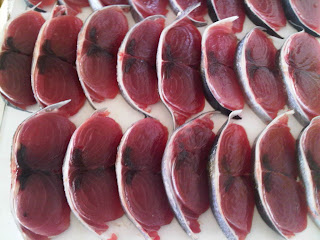GENERAL SANTOS FISHPORT COMPLEX
( TUNA CITY OF PHILIPPINES )
The construction of General Santos Fish Port Complex(GSFPC) was funded by Overseas Economic Cooperation Fund(OECF) of Japan. GSFPC is the nation’s second largest fish port after Navotas, and considered the most modern in the country today. The construction started last December 1994 and finished in March 1999.
Aerial view of the General Santos Fishport Complex.
REFRIGERATION FACILITIES
Ice Making Plant 60 tons/day
Ice Storage 60 tons/day
Ice Crusher 20 tons/hour
Cold Storage, -35°C 1,500 tons (6 x 250 tons)
Contact Freezer, -45°C (4 units) 288 kg./cycle/3-4 hr./unit
Air Blast 14 tons/day
Brine Freezer 50 tons/day
Ice Storage 60 tons/day
Ice Crusher 20 tons/hour
Cold Storage, -35°C 1,500 tons (6 x 250 tons)
Contact Freezer, -45°C (4 units) 288 kg./cycle/3-4 hr./unit
Air Blast 14 tons/day
Brine Freezer 50 tons/day
BUILDING FACILITIES
Fish Market (3 units) 6,000 sq.m.
Refrigeration Building 7,000 sq.m.
Maintenance Shop 360 sq.m.
Administrative Building 420 sq.m.
Net Mending Shed(4 units) 160 sq.m.
Public Toilets 120 sq.m.
Fresh Water Pump House 19.36 sq.m.
Fire Pump House 12.00 sq.m.
Sea Water Pump House 19.04. sq.m.
Fish Market (3 units) 6,000 sq.m.
Refrigeration Building 7,000 sq.m.
Maintenance Shop 360 sq.m.
Administrative Building 420 sq.m.
Net Mending Shed(4 units) 160 sq.m.
Public Toilets 120 sq.m.
Fresh Water Pump House 19.36 sq.m.
Fire Pump House 12.00 sq.m.
Sea Water Pump House 19.04. sq.m.
Yellowfin Tuna
The impact of the growing tuna industry of General Santos City has been inviting in-migrants seeking employment in any of the canning factories or sashimi-exporters for the Japan market. The rate of population growth has notably increased in an alarming rate of 2.64% per annum for the last 5 years. This means that the city’s population increases at about 10,000 warm bodies per month. The study is based on the trend analysis on General Santos City migration.
Since the start of GSFPC’s operation, unloading of tuna and tuna-like species has dramatically increased. Fish unloading started at the fishport’s market 1 with the recorded volume of 515, 160 kgs., for the month of April 1998, where majority of the catch consists of yellowfin tuna.
Fish unloading dramatically increased on August 1998, when market 2 which caters to baby purseiners and mixed species of fish producers opened, showing an increase in total fish unloading of 118% based on the April 1998 data.
Apparently, another abrupt increase in tuna unloading was noted when the port’s Market 3 accommodating large purseiners opened on March 1999 increasing the volume by 227% compared to August 1998 data.
Apparently, another abrupt increase in tuna unloading was noted when the port’s Market 3 accommodating large purseiners opened on March 1999 increasing the volume by 227% compared to August 1998 data.
The captured tuna and tuna-like fishes have been monitored to be delivered to 3 major destinations. These include the canneries, the processors/exporters, and the local market catering the local consumers.
We started distributing Tuna products from General Santos City December of 2009 as addition to the products we are selling for retail. What started as a test supply soon expanded to the distribution of the product to other establishments like Bars, Grill Houses, Restaurants and Resorts. Now we are expanding and we are seeing a bigger market share through exports.
Unlike other competition that relies solely on the availability of the products from those locally produced by fisherman we on the other hand get our product direct from the “tuna fish port” . This would simply say that the products we sell goes with the highest quality before being allowed to leave the processing area. And with that we could say that we a have secured a better supplying capacity than the rest.
Our Tuna comes at the highest of quality the moment they arrived till they are delivered. They are fresh frozen and sealed ensuring great texture when served. Since the exporters already provided the system of making sure that everything that comes out of the factory passes international standards in terms of quality.
Having been raised in this area provides greater opportunity in pulling in as many resources as possible allowing us to move with greater success because of the harmonious cooperation we get from our people. In terms of financial stability we are fast growing and the cash flow that we have is allowing us to increase and expand. We also have a handful of investors that provides us financial backing and with this we are confident that we could meet the demand our clients.
In order to meet the individual needs of our clients we maintain a wide range of products and matched the client’s needs with the factory output capacity on a year round basis. We already established a good supply system for our Tuna Belly and Tuna Panga meaning at any given season we could provide this needed products unlike the rest which relies only with the days catch.













